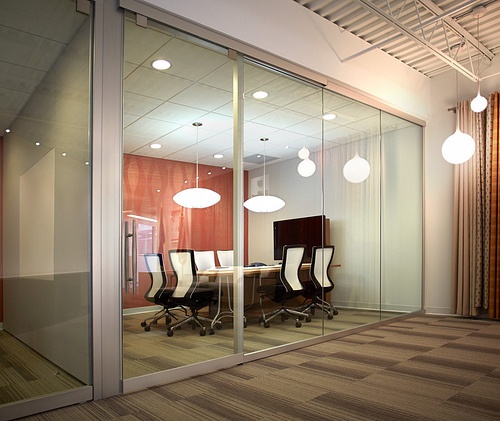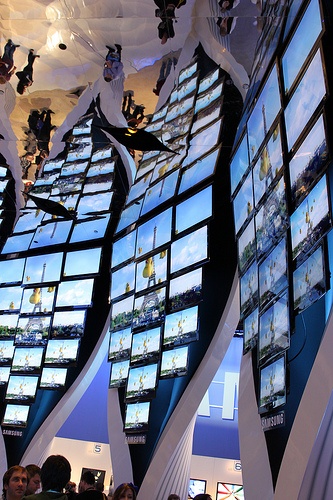AV Technology in the classroom is no longer a phenomenon. Just visit your own child's school and classroom, and you notice how technology is playing a key role in K-12 education today. According to the U.S. Department of Education, computers are in 97 percent of classrooms every day, and the adoption of new easy-to-use technologies by teachers is growing.
Its not just K-12. Classroom technology is a perfect fit for higher education, training facilities and more.
Read More
Topics:
AV,
classroom AV,
learning,
K-12,
higher education,
classroom technology
With the convergence of AV and Networking continuing to trend upward, installation of networked AV capture and streaming technology is another opportunity for professional AV integrators to take advantage of.
Read More
Topics:
Remote Workforce,
AV,
HD Video Conferencing,
remote learning,
av capture,
streaming,
lecture capture,
distance learning,
lecture recording,
sharing,
on-demand
Huddle rooms are one of the hottest trends in the AV industry today. Wainhouse Research estimates the potential for huddle rooms to be between 30 and 50 million rooms. As a professional integrator, you can provide great benefit to your customers by educating them on the flexibility and cost effectiveness of huddle rooms.
Read More
Topics:
Wireless,,
BYOD,
video conferencing,
remote working,
Remote Workforce,
AV,
HD Video Conferencing,
Huddle Room,
huddle rooms
By Robert D'Addario
"Fiber is coming." This assertion seems like the battle cry for the better part of the last two decades. Why pay attention now? Every year it seems some technology company figures out how to bleed that last bit of extra bandwidth out of twisted pair category cable, so why can't they keep doing that forever? Why invest in the training, skill set and frustration of dealing with fiber?
Read More
Topics:
AV Integration,,
AV over IP,
bandwidth,
Ultra HD,
Digital Data,
Fiber optics
Fiber optics has been heralded as the future of communications technology. It can distribute Internet data at record speeds, over 100 kilometers, compared to regular ethernet cables that transmit data only within 100 meters. Plus, fiber optic cables are as thin as a human hair and are known for their fault-tolerance capabilities. With rapid advances in technology and increasing worldwide market demand, fiber is shining bright in the communication spotlight, and fueling future trends for the technology.
Read More
Topics:
Digital Data,
Fiber Optics and Telecommunications,
Fiber Optics and Server Farms,
The Future of Fiber Optics,
Fiber optics
The effects of technology are everywhere. Along with all the benefits it brings us come specific challenges. How these challenges are addressed is what makes technology evolve. A recent change in live audio is the shift towards networked digital audio. You won’t actually hear the change since it doesn’t affect the final output. What will change is how sound makes its way to the amplifiers and speakers. With networked audio, “analog-to-digital conversion [takes] place at the stage box, with the audio signal staying digital until it hits an amplifier on the way to a speaker.” For live event producers, networked digital audio brings new waves in integrating sound with other digital elements. It also brings challenges in terms of design and installation.
Read More
Topics:
bandwidth,
networked audio systems,
LAN sharing,
audio,
AV,
network digital audio,
big event audio video
New trends in Technology and evolving business needs are leading organizations to retrofit their conference rooms. They are converting them from mere meeting rooms to workplaces of the future. These new technologies in conference venues lead to the current effectiveness of today’s meetings. Let us take a look at five of the most relevant technologies which makes your workplace future ready.
HD Videoconferencing Technology
The current business culture thrives on collaboration. This creates a new challenge. How do you maintain a proper balance between managing costs and delivering effective results? Equipping your conference rooms with effective HD Videoconferencing Technology makes this possible. High Definition videoconferencing is a perfect way to establish clear eye contact with your team. Members in different locations will feel as if they are in the same room because of the clarity of sound, picture, and content. That is precisely what today’s technology aims to achieve.
Read More
Topics:
video conferencing,
Whiteboards,
audio,
Remote Workforce,
AV,
HD Video Conferencing
High Definition (HD), Super HD and finally Ultra HD - they all exist. The question is where do we go from here? As viewing quality exponentially grows, are we heading towards a point where our eyes will stop discerning all these extra pixels?
Technology evolves at a rapid pace. With mobile devices becoming the first-screen, users are demanding higher definition, especially in terms of video quality. Driven by such demands, new gadgets like 4K tablet computers and iMac computers with a 5K Retina display are making high-resolution a reality for large and small screen environments.
Read More
Topics:
BYOD,
video conferencing,
mobile technology,
Cloud Computing,,
remote working,
Ultra HD
Wireless technology transforms the way businesses operate. When enterprise mobility is a major issue with small and medium sized organizations, and flexibility of operations often impacts how the client perceives a business, the utility and relevance of wireless communication cannot be sidelined. However, all technology comes with its limitations. Nonetheless, there is a way to bypass them and find a better route to attain objectives. It is important to remember that though wireless networks play a significant role in enhancing productivity and encouraging collaboration, its limitations are best tackled by simply staying wired in certain situations. In this piece, we are going to take a closer look at four instances where a wired Internet connection will better serve our purpose.
Read More
Topics:
wireless working,
audio video quality,
Mobile,
dropped internet,
hard wired internet,
bandwidth,
mobile technology
Do you have a home network? How about a wireless router? It’s no surprise if you answered, yes. Home networks have gained popularity over the past few decades, and so has the wireless router. Wireless has made the world a more connected place, allowing us to remain in contact almost anytime, anywhere as long as there is a good signal available. Wi-Fi has led to the downfall of wired networks, and for many users, Ethernet cords are now old-fashioned. Have wired connections become totally obsolete? Not really. Most industry experts believe that cable is likely to stand the test of time.
Read More
Topics:
Wireless,,
Security,,
Cable,








